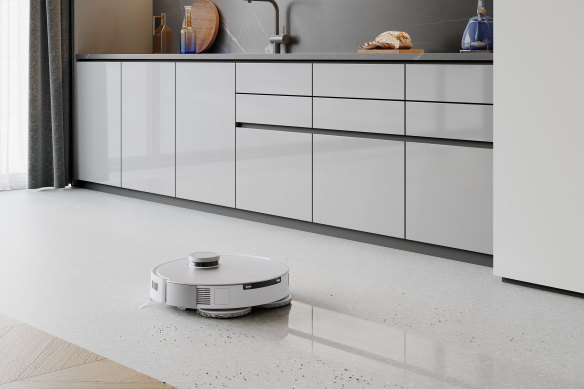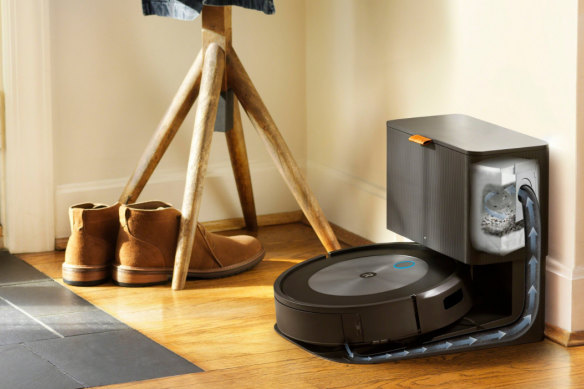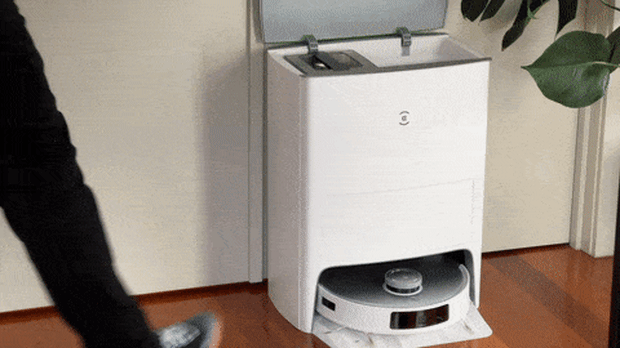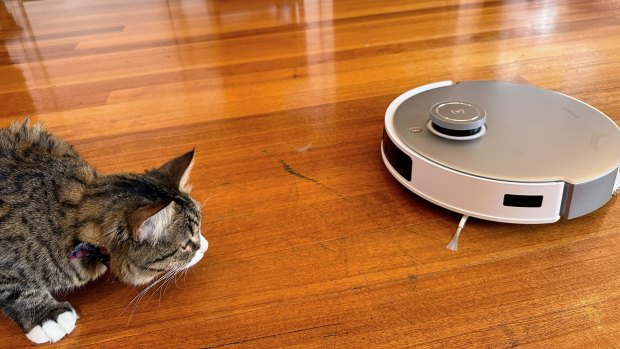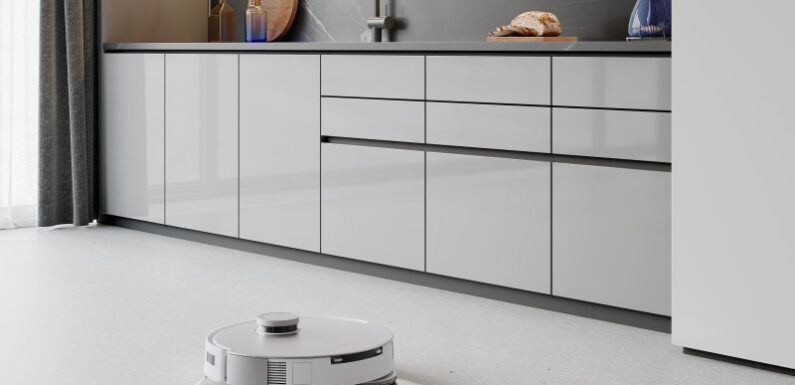
Save articles for later
Add articles to your saved list and come back to them any time.
I’ve had robot vacuums in my house for almost 10 years. And while the technology has grown by leaps and bounds — to add mopping, and voice assistant compatibility, and memory, so they can pick up where they left off — in some ways, things haven’t changed.
I still think of them as bumbling idiots most of the time, and you still need a stick vac on hand for certain jobs, but they do still manage to take care of the bulk of an annoying job.
New robot vacuums, like the Ecovacs T20 Omni, have a lot more tricks than just rolling and sucking.
Living with a robot
The benefits of a cleaning robot are pretty self-evident; your floors are always nice, and there’s less dust and allergens blowing around. But while most companies sell their robots as secret ninja maids that zhuzh up your place while you’re not looking, there’s generally a little more to it.
Many robots will work to a regular schedule if you set them up to, and some will also work with your smart home to only clean when you’re out. But all of them require you to do a bit of tidying before they get to work. Ideally, you’ll lift your chairs and small furniture off the ground and move any rugs, but at a bare minimum you have to get clothes, toys and anything tassled away from where robot will go. The tech has advanced a lot since a few years ago when a Roomba I was testing ate a bra and died under the bed, but it’s still not perfect.
Given they are vacuums, there’s obviously a bit of noise involved. They’re getting better, and more customisable, but none of them are silent. And if it’s a model that empties its own dust and dirt into a filter bag inside its base – like iRobot’s $1700 Roomba i7+ and $2200 Combo j7+, Roborock’s $2000 Q Revo, or the $1800 Ecovacs T20 Omni I’m currently testing – your kids will quickly learn that when the low whirring of the robot stops suddenly they have just enough time to cover their ears before the jet engine ejection noise. If you don’t mind cleaning out the dust bin daily, there are plenty of simpler models that still pack a lot of new tech, like the $1000 Roomba i3 or $800 Deebot N10, and you can generally find these at steep discounts.
Many robots how have filter bags hidden in their bases, meaning you don’t have to empty them for weeks or months at a time, but you do have to buy new bags.
Early cleaning robots were something you just placed in a corner and let them go until they made it to the other side, and I found their constant bumping and turning endearing. Today’s AI-powered and mapping-capable models are more confident, but I still can’t keep from anthropomorphising them. Some send you smartphone notifications like “Combo is stuck and needs your attention”, while others actually talk. “Cleaning mop pads,” the T20 calls out to nobody in particular. Or “I’m here!” when it erroneously decides my wife is trying to talk to it for the third time this hour (I turned its built-in microphones off after this).
Most new robots have sensors or cameras to create and update maps of your house, which will understandably be a turn-off for some. New iRobot models will even send you photos of underneath your couch, passive-aggressively asking whether the shoe you left there is a permanent or temporary obstacle. The T20 Omni added our deck to its map because it can see it out the window, though obviously, it never cleans there because it can’t get through the glass door. I guess I should consider that a failure of its processing, but instead I feel it’s kind of sad.
More autonomy, but more maintenance
In addition to bagging their own dust, many new models also come with the ability to mop and vacuum at the same time. But sometimes, more complicated designs mean more for you to do, and the time, energy and money calculus of a robot vac versus a manual one becomes more difficult. The T20 Omni offers a striking example here.
This is a big robot that lives in an enormous base, and it’s designed to vac and mop your whole house, with hot water, while also cleaning and drying its own mop pads and ejecting its own dust. And while part of its operation could definitely be called autonomous, it still needs human help.
Inside its big house are two water tanks. One you need to fill with clean water, which it runs through a heating pipe and uses to fill a sink under the robot. It soaks its mop pads there, then heads off to clean. It can detect when extra cleaning is needed, or when it hits carpet and so needs to raise its wet pads, and it will plan to come back several times to get more water or recharge. The dirty water from the pads gets sucked into the second water tank, which you need to empty. I can imagine a future version of this with a washing-machine-style inlet and pipe, so it could fill and drain its own tanks, which would make its day-to-day totally autonomous.
Clean water in, dirty water out (this clip is edited and sped up). Credit: Tim Biggs
But you’d still have regular maintenance and so-called consumable parts to contend with. The manual for the T20 Omni recommends a weekly cleaning regimen of all the robot’s parts, as well as a deep scrub of elements like the brushes, sink and tanks every few weeks to a month. It’s not a huge job, but it will have you contemplating whether you could just get by vacuuming the house once a week instead. Also onerous is the ongoing cost of having to buy new pads, dust bags, brushes and filters every six months or so.
Different robots have different setups. The Combo j+ for example has its mop pads on a hinge and carries its own water reservoir, which is good because it means it can handle deeper carpets than the Deebot (which can only lift its wet pads so high), but it also means more manual filling and rinsing. Regardless, you’re still looking at regular maintenance and replacement parts. Don’t think you can get away with reusing bags and filters like I once did, and end up with a case of what I’m pretty sure were mould mites.
A fur baby’s friend, or foe
In my experience, pets all have one of two reactions to robot vacuum cleaners; they either fear them and retreat, or they mess with them mercilessly. Our cat, Risky, falls squarely into the latter camp. He bats and licks the rotating brushes, and I’m not sure whether that’s worse for our floors or his health.
He pounces from behind plants for a quick swipe and darts away. He lays in the robot’s path and refuses to move despite its prodding. It’s simply impossible to stop him, although he doesn’t seem to like walking through the wet parts of the floor during mopping, which is good.
Moments before a big boop.Credit: Tim Biggs
Most vacs are designed to detect objects ahead and avoid damaging them, though this is obviously harder to do when the object is moving maliciously. Of all the vacs I’ve tested, I’ve never had one hurt a pet, but I have had a few be cornered and eventually give up or run out of battery without being able to return home.
Ordinarily I just leave the robot to do its job, and in most cases it will work around the animals. The T20 Omni is an interesting case though because it provides a very detailed map that you can watch on your phone in real time, or see a complete record of where the robot went after the fact. So I can see clearly that, amongst the grid of straight lines and occasional rotations where it’s detected a patch that needs extra cleaning, the robot had to make way for a cat-shaped lump two or three times per clean.
On the other hand, running the vac every day is definitely worth it to take care of the tail hair tumbleweeds that would otherwise congregate and blow around the place.
The internet is full of videos where robot vacuums have been turned into makeshift pet companions by sticky taping some toys to it or putting some treats on top, and if you think your cat might be content to ride on the robot rather than fight it, you could give that a try.
But I think I’ll stick to discouraging contact as much as possible.
Get news and reviews on technology, gadgets and gaming in our Technology newsletter every Friday. Sign up here.
Most Viewed in Technology
From our partners
Source: Read Full Article
